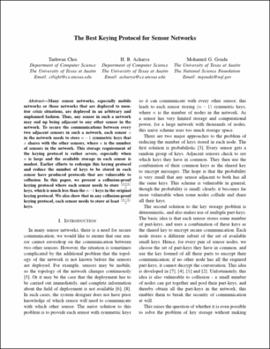| dc.contributor.author | Choi, Taehwan | |
| dc.contributor.author | Acharya, HB | |
| dc.contributor.author | Gouda, Mohamed G | |
| dc.date.accessioned | 2024-01-17T19:43:48Z | |
| dc.date.available | 2024-01-17T19:43:48Z | |
| dc.date.issued | 2013-08 | |
| dc.identifier | oksd_choi_best_keying_protocol_for_2012 | |
| dc.identifier.citation | Choi, T., Acharya, H.B., Gouda, M.G. (2013). The best keying protocol for sensor networks. Pervasive and Mobile Computing, 9(4), pp. 564-571. https://doi.org/10.1016/j.pmcj.2012.06.007 | |
| dc.identifier.issn | 1574-1192 | |
| dc.identifier.uri | https://hdl.handle.net/11244/340119 | |
| dc.description.abstract | Many sensor networks, especially mobile networks or those networks that are deployed to monitor crisis situations, are deployed in an arbitrary and unplanned fashion. Thus, any sensor in such a network may end up being adjacent to any other sensor in the network. To secure the communications between every two adjacent sensors in such a network, each sensor x in the network needs to store n − 1 symmetric keys that x shares with the other sensors, where n is the number of sensors in the network. This storage requirement of the keying protocol is rather severe, especially when n is large and the available storage in each sensor is modest. Earlier efforts to redesign this keying protocol and reduce the number of keys to be stored in each sensor have produced protocols that are vulnerable to collusion. In this paper, we present a collusion-proof keying protocol where each sensor needs to store (n+1)/2 keys, which is much less than the n−1 keys in the original keying protocol. We also show that in any collusion-proof keying protocol, each sensor needs to store at least (n−1)/2 keys. | |
| dc.format | application/pdf | |
| dc.language | en_US | |
| dc.publisher | Elsevier | |
| dc.relation.ispartof | Pervasive and Mobile Computing, 9 (4) | |
| dc.relation.uri | http://dx.doi.org/10.1016/j.pmcj.2012.06.007 | |
| dc.rights | This material has been previously published. In the Oklahoma State University Library's institutional repository this version is made available through the open access principles and the terms of agreement/consent between the author(s) and the publisher. The permission policy on the use, reproduction or distribution of the material falls under fair use for educational, scholarship, and research purposes. Contact Digital Resources and Discovery Services at lib-dls@okstate.edu or 405-744-9161 for further information. | |
| dc.title | The best keying protocol for sensor networks | |
| dc.date.updated | 2024-01-12T21:59:55Z | |
| osu.filename | oksd_choi_best_keying_protocol_for_2012.pdf | |
| dc.identifier.doi | 10.1016/j.pmcj.2012.06.007 | |
| dc.description.department | Computer Sciences | |
| dc.type.genre | Preprint | |
| dc.type.material | Text | |
| dc.subject.keywords | integer transfinite diameter | |
| dc.subject.keywords | lemniscate | |
| dc.subject.keywords | Mahler measure | |
| dc.rights.license | https://creativecommons.org/licenses/by-nc-nd/4.0/ | |
